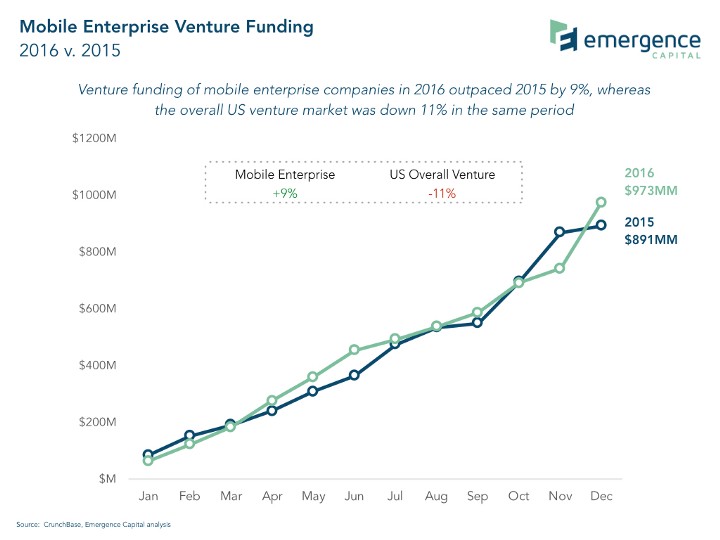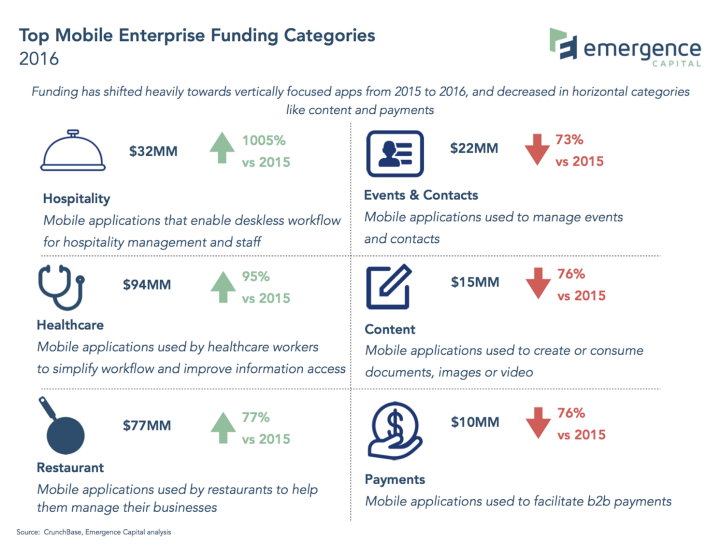After a Decade, the Mobile Enterprise Revolution Has Only Just Begun

It’s been about a decade since the debut of the first smartphones, and in that time they’ve wound up in the hands of more than 2 billion people.
It’s hard to fully account for all the changes big and small in our daily life and expectations that we can attribute to Apple’s iPhone, which first went on sale in the summer of 2007 and Google’s Android operating system, which first debuted in late 2008. How we communicate, organize our lives, and even shop have all permanently changed because of the smartphone (and its cousin, the tablet). And from that standpoint it might be fair conclude that the moment for investing in the mobile revolution has passed.
And yet the mobile opportunity is only beginning, though it has moved into a new phase driven by innovation in the enterprise, and applications aimed at workers who spend the bulk of their productive time away from a desk. It’s for this reason that we publish the Mobile Enterprise Trends Report, the newest version of which we are releasing today.
Last year was huge for companies building mobile enterprise apps. One of our portfolio companies, ServiceMax, was acquired by GE for $1 billion, marking the first billion-dollar exit of a mobile enterprise company. It was one of five acquisitions of mobile enterprise players during the year, totaling more than $2 billion.
Meanwhile venture investments in mobile enterprise companies in 2016 rose 9 percent to $973 million from the prior year, at a time when venture investments overall declined by 11 percent.
There are several reasons that investors — including us here at Emergence Capital — are showing so much enthusiasm for mobile enterprise investments. The first is the historic impact that millennials are having on the labor force. These younger workers already make up the largest age group working today and will account for more than half of the workforce by 2020. And about 20 percent of those workers are “mobile only” meaning they don’t use a traditional desktop or notebook PC to do their jobs.
Meanwhile there’s another huge group of workers that has until now, been largely neglected by the incumbent enterprise software companies. We call them deskless workers, and they make up about 80 percent of the work force, doing a thousands of different kinds of jobs, in industries including health care, hospitality and field service, that can’t be done effectively while sitting at a desk. Companies spend about $250 billion on software every year, and only a small portion of that has been devoted to mobile apps.
Third is a constant worry of CEOs and CIOs: Boosting worker productivity. In a 2013 survey of 300 IT decision makers at large companies in the U.S. and the U.K. predicted that by making their enterprise applications more mobile-ready, they could boost the efficiency of their workers by nearly 40 percent or more.
So where are the investments in mobile enterprise companies going? We analyzed 2016 venture funding data from Crunchbase and found that investments in mobile applications aimed at vertical industries are growing while investments in horizontal business apps are on the decline.
In 2016, health care apps attracted $94 million VC investments, an increase of 95 percent over the prior year. Apps for the hotel and hospitality industry raised $32 million, up more than 1,000 percent from 2015, and restaurant apps raised $77 million, an increase of 77 percent. By comparison investments in contacts, content and payment apps all declined year-on-year by more than 70 percent each.

Overall that number is rising but at a slower pace than in recent years. In 2016 the number of companies in our Mobile Enterprise Landscape numbered 358, up 14 percent from the prior year. In 2015 that number grew 21 percent to 313.

There’s a few reasons for the slower rate of company-creation: First, building an enterprise app across multiple platforms — iOS, Android and others — is fundamentally more difficult that building a browser-based SaaS application. It’s also more difficult to manage the sales and marketing processes in a business environment that relies on app stores.
Second, we think there are fewer software entrepreneurs who fully appreciate the opportunities that deskless workers present. Most are still focused on the traditional desk-bound worker.
So where does this leave us as 2017 unfolds? Here’s a few things to watch for:
- Another mobile enterprise company will be acquired for $1 billion or more. The traditional enterprise software companies — Oracle, SAP, Microsoft and IBM — will realize how far behind they are on the mobile front. The buyer will likely pay a strategic premium that will value the target at a higher multiple than its industry peers. This will in turn, boost the valuations of other potential targets in the space.
- More companies will focus on mobile devices that are neither tablets nor phones. Several companies on our Mobile Enterprise Landscape are working on products for use with drones and head-mounted displays. As this type of hardware becomes more capable and less expensive, their potential value to deskless workers will increase.
- More mobile enterprise companies will be created outside of Silicon Valley than inside it. There are a few reasons for this, but the big one is that mobile platforms are preferred by business users outside the U.S. Entrepreneurs in these “mobile-first” markets understand that and act accordingly. Second, entrepreneurs from outside Silicon Valley tend to understand the plight of the deskless worker better than those from inside it.
As much as mobile technology has changed about our personal lives in the last decade, we think the changes it will bring in how we work may be even bigger. We feel so strongly about this enterprise-centric phase of the mobile revolution that we’ve been aggressively investing in mobile enterprise companies. We closed six mobile enterprise investments in 2016, more than any other venture firm. We expect that Emergence will continue to be a very active investor in this space in 2017 and beyond.
As much as mobile technology has changed about our personal lives in the last decade, we think the changes it will bring in how we work may be even bigger. For more information on the mobile enterprise market, check out our latest Mobile Enterprise Trends Report below.
https://www.slideshare.net/EmergenceCapital/emergence-capital-mobile-enterprise-trends-march-2017
Enjoying this article?
Sign up to gain access to our thought leadership and have future articles delivered directly to your email.